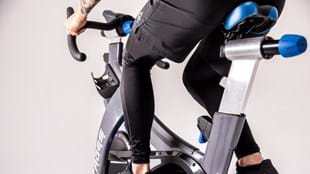Amir H Behforooz: “If a member has lower back pain, what’s the best way to set up the bike?”
Those who suffer from lower back pain should aim to keep the spine as close to neutral (slight inward curve in the lower back) as possible throughout the workout. This is often easier with the handlebars set slightly higher than the seat to avoid having to flex the spine. In addition, care is needed when transitioning out of the saddle into standing, take these transitions at your own pace.
Cycling can be a great cardiovascular option for those recovering from lower back injury, providing a comfortable alignment is maintained and the intensity is managed carefully.
Lana Endersby: “Love to understand more about the all muscles we engage in each position. Especially for members with concerns about building big legs or who have slight pain in certain areas.”
The key muscles engaged during the pedal action are our push muscles (glutes and quads) and pull muscles (hamstrings, hip flexors).
These muscles combine to move the pedals through the 360 degree revolution. The various positions used in RPM allow these muscles to be used through different ranges of motion. For example – seated with his back in the saddle - will place the hips in more flexion – creating more stretch in the glutes and hamstrings. Standing attacks with the hips forward will create a more extended start position.
Like most things – cycling is very individual, muscle recruitment will vary between individuals.
Kelly Olsen Williams: “My riders love anything heart rate related, so anything about the drills we do and why we do them in regards to cardio training would be something they'd be interested in. I have a few who are the type who immediately flip up their wrist at the end of each interval round to check their heart rate.”
RPM is considered cardio peak training – meaning we train with short bursts of high intensities of an aerobic base. These fluctuations help to improve fitness and create variety within the workout.
The majority of the workout is spent in the moderate to vigorous zone – 60 to 85% of max heart rate with short bursts of effort occasionally taking us above 85%.
A study conducted on inactive adults demonstrated that 8 weeks of RPM can improve VO2 (aerobic fitness) by 12%.
Heather Anderson: “Clarify for the non Les Mills Instructors out there how you can safely ride at over 110/120bpm!”
RPM occasionally uses tracks with music speeds exceeding 110 / 120 bpm. These tracks stimulate riders to ride at their own maximum top pace.
Mixing these faster phases with some of the slower tracks provides training variety and mixes up muscle recruitment.
A review on higher cadence training has shown there is minimal potential for injury when riding at these top speeds providing participants maintain good form.
SO WHAT DOES OUR RESEARCH INTO CYCLE MEAN FOR YOU?
RPM EFFECT STUDY
This study involved eight overweight, physically inactive but otherwise healthy adults completing eight weeks of three RPM™ classes per week. Cardio fitness improved (11.8 percent increase in VO2 and 7 percent reduction in systolic blood pressure), body composition improved (body fat reduction of 13.6 percent and waist circumference by 3cm) and total cholesterol reduced by 13 percent.
What it means for you: you can tell your new-comers to exercise that RPM is an effective way to improve cardio fitness, lose body fat and reduce cholesterol levels.
THE LES MILLS SPRINT INTERVENTION
Science proved LES MILLS SPRINT was effective in reducing body fat mass, blood pressure, total cholesterol and triglyceride concentration while enhancing cardiovascular fitness, lean body mass, glucose intolerance and strength.
What it means for you: you can tell your regular participants that replacing just one session of moderate intensity exercise with two HIIT classes per week for six weeks will significantly improve their health, fitness and strength.
THE TRIP STUDY
This study shows that novice exercisers experienced a reduced perception of intensity from the audio-visual experience of THE TRIP™. Its immersive qualities enhance their fitness experience and may assist with them keeping up with a regular exercise program going forward.
What it means for you: you can tell your new-comers to exercise that THE TRIP is an ideal way to start their fitness journey.
Got a question? Contact Instructor@lesmills.com, we’d love to hear from you!







